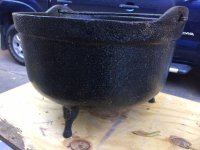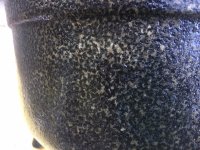I got a 5-gallon cauldron from a friend who wants to put it back into use. No manufacturers' markings, but it's large enough and old enough to have two parallel gate marks on the bottom. It is either heavily pitted inside and out or was very coarsely cast. It has apparently been used as a garden ornament as it has also been painted.
I've had in the electro tank four days now (8 amp so it's taking a while.) After two days I noticed the paint on the outside starting to bubble off so I took a pressure washer to it and got most of the paint off. As you can see from the photos, the bottom of the pits are still black. I can't tell if this is paint or seasoning. Of course in order to cook in it, I want all the paint gone.
Any idea of what I'm dealing with here? My guess is to put it back into the electro tank. Any better ideas?


I've had in the electro tank four days now (8 amp so it's taking a while.) After two days I noticed the paint on the outside starting to bubble off so I took a pressure washer to it and got most of the paint off. As you can see from the photos, the bottom of the pits are still black. I can't tell if this is paint or seasoning. Of course in order to cook in it, I want all the paint gone.
Any idea of what I'm dealing with here? My guess is to put it back into the electro tank. Any better ideas?


